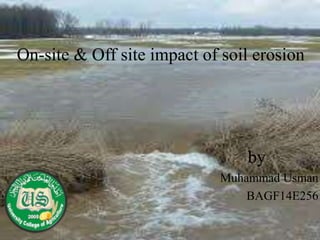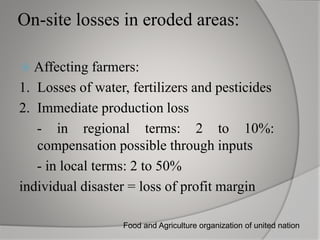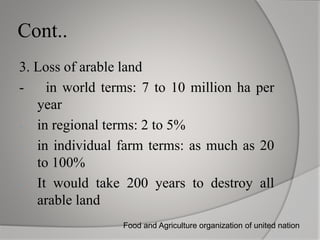Usman
- 2. On-site & Off site impact of soil erosion by Muhammad Usman BAGF14E256
- 3. On-site losses in eroded areas: Affecting farmers: 1. Losses of water, fertilizers and pesticides 2. Immediate production loss - in regional terms: 2 to 10%: compensation possible through inputs - in local terms: 2 to 50% individual disaster = loss of profit margin Food and Agriculture organization of united nation
- 4. Cont.. 3. Loss of arable land - in world terms: 7 to 10 million ha per year - in regional terms: 2 to 5% - in individual farm terms: as much as 20 to 100% - It would take 200 years to destroy all arable land Food and Agriculture organization of united nation
- 5. Cont.. 4. Long-term productivity loss = SOIL MEMORY - Reduced depth of topsoil - Reduced water and nutrient storage - Reduced effectiveness of rain and inputs - Reduced economic viability = soil depletion Food and Agriculture organization of united nation
- 6. Off-site impacts: Affecting townspeople: 1. Deterioration in water quality: pollution of rivers, death of fish, silting up of reservoirs 2. Increase in suspended load (SL) higher costs for drinking water Food and Agriculture organization of united nation
- 7. Cont.. 3. Flooding of inhabited areas: mud flows, sanded up ditches 4. Rise in peak flows of rivers: destruction of structural works, bridges, etc. 5. Eutrofication Food and Agriculture organization of united nation
- 8. Cont….. Water erosion’s main off-site effect is the movement of sediments and agriculture pollutants into watercourses. This can lead to the silting-up of dams, disruption of the ecosystems of lakes, and contamination of drinking water . In some cases increase downstream flooding may also occur due to the reduce capacity of eroded soil to absorb water. Food and Agriculture organization of united nation







